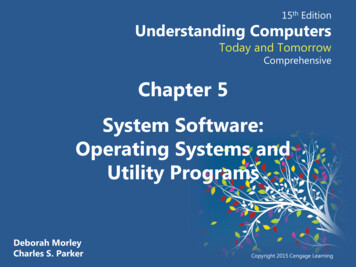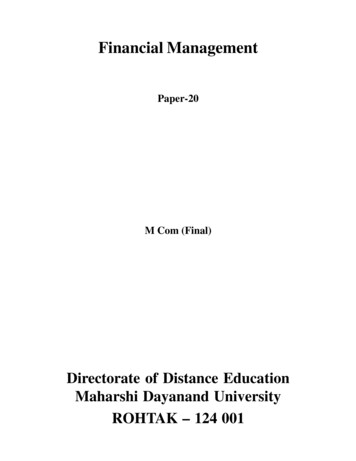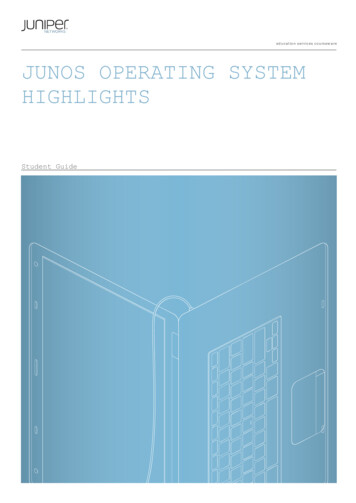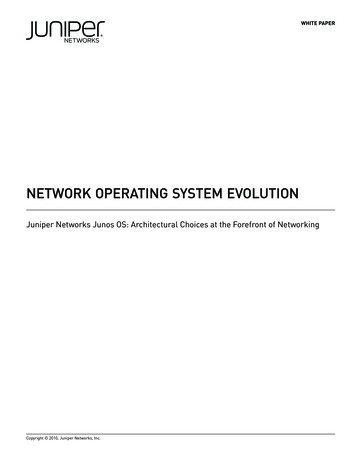
Transcription
15th EditionUnderstanding ComputersToday and TomorrowComprehensiveChapter 5System Software:Operating Systems andUtility ProgramsDeborah MorleyCharles S. ParkerCopyright 2015 Cengage Learning
Learning Objectives1. Understand the difference between system software andapplication software.2. Explain the different functions of an operating system anddiscuss some ways that operating systems enhanceprocessing efficiency.3. List several ways in which operating systems differ from oneanother.4. Name today’s most widely used operating systems forpersonal computers and servers.Understanding Computers: Today and Tomorrow, 15th Edition2
Learning Objectives5. State several devices other than personal computers andservers that require an operating system and list one possibleoperating system for each type of device.6. Discuss the role of utility programs and outline several tasksthat these programs perform.7. Describe what the operating systems of the future might belike.Understanding Computers: Today and Tomorrow, 15th Edition3
Overview This chapter covers:– Differences between system software and applicationsoftware– Functions of and general differences between operatingsystems– Specific operating systems most widely used today– Functions of and various types of utility programs– A look at future of operating systemsUnderstanding Computers: Today and Tomorrow, 15th Edition4
System Software vs. ApplicationSoftware System Software– The operating system and utility programs that control acomputer system and allow you to use your computer Enables the boot process, launches applications,transfers files, controls hardware configuration,manages files on the hard drive, and protects fromunauthorized use Application Software– Programs that allow a user to perform specific tasks on acomputer Word processing, playing games, browsing the Web,listening to music, etc.Understanding Computers: Today and Tomorrow, 15th Edition5
The Operating System Operating System– A collection of programs that manage and coordinate theactivities taking place within a computer– Acts as anintermediarybetween theuser and thecomputer andbetween theapplication programsand system hardwareUnderstanding Computers: Today and Tomorrow, 15th Edition6
Functions of an Operating System Interfacing with Users (typically via a GUI) Booting the Computer– Loads essential part of operating system (kernel) intomemory– Reads opening batch of instructions– Determines hardware connected to computer Configuring Devices– Device drivers are often needed; can be reinstalled ifneeded– Plug and Play devices are recognized automaticallyUnderstanding Computers: Today and Tomorrow, 15th Edition7
Functions of an Operating System Managing Network Connections– Manages wired connections to home or office network– Manages wireless connections at home, school, work, oron the go Managing and Monitoring Resources and Jobs– Makes resources available to devices and programs– Monitors for problems and attempts to correct those thatarise– Schedules jobs Jobs to be printed Files to be retrieved from hard driveUnderstanding Computers: Today and Tomorrow, 15th Edition8
Functions of an Operating System File Management– Keeps track of stored files on computer so they can beretrieved when needed Files usually viewed in a hierarchical format Security– Passwords– Biometric characteristics– FirewallsUnderstanding Computers: Today and Tomorrow, 15th Edition9
Functions of an Operating SystemUnderstanding Computers: Today and Tomorrow, 15th Edition10
Processing Techniques for IncreasedEfficiency Multitasking– The ability of an operating system to have more than oneprogram (task) open at one time CPU rotates between tasks Switching is done quickly Appears as though all programs executing at the sametimeUnderstanding Computers: Today and Tomorrow, 15th Edition11
Processing Techniques for IncreasedEfficiency Multithreading– The ability to rotate between multiple threads so thatprocessing is completed faster and more efficiently– Thread Sequence of instructions within a program that isindependent of other thread Multiprocessing and Parallel Processing– Multiple processors (or multiple cores) are used in onecomputer system to perform work more efficiently– Tasks are performed sequentiallyUnderstanding Computers: Today and Tomorrow, 15th Edition12
Processing Techniques for IncreasedEfficiencyUnderstanding Computers: Today and Tomorrow, 15th Edition13
Processing Techniques for IncreasedEfficiency Memory Management– Optimizing the use of main memory (RAM)– Virtual memory Memory-management technique that uses hard drivespace as additional RAMUnderstanding Computers: Today and Tomorrow, 15th Edition14
Processing Techniques for IncreasedEfficiency Buffering and Spooling– Buffer Area in RAM or on the hard drive designated to holddata that is used by different hardware devices orprograms– Buffering or Spooling Placing items in a buffer so they can be retrieved by theappropriate device when neededUnderstanding Computers: Today and Tomorrow, 15th Edition15
Differences Among OperatingSystems Command Line Interface– Require users to input commandsusing the keyboard Graphical User Interface– Graphics based interface– Used by most operating systemsUnderstanding Computers: Today and Tomorrow, 15th Edition16
Differences Among OperatingSystems Categories of Operating Systems– Personal (Desktop) Operating Systems Designed to be installed on a single computer– Server (Network) Operating Systems Designed to be installed on a network server Client computers still use a personal operating system Server operating system controls access to networkresources– Mobile and embedded operating systems are alsocommonUnderstanding Computers: Today and Tomorrow, 15th Edition17
Differences Among OperatingSystemsUnderstanding Computers: Today and Tomorrow, 15th Edition18
Differences Among OperatingSystems The Types of Processors Supported– Desktop, mobile, server processors– 32-bit or 64-bit CPUs Support for Virtualization and Other Technologies– New types of buses– Virtualization– Mobility– Security concerns– Power-consumption concerns– Touch and gesture input– The move to cloudUnderstanding Computers: Today and Tomorrow, 15th Edition19
Quick Quiz1. Which of the following processing techniques allows acomputer to work with more than one program at a time?a. Parallel processingb. Virtual memoryc. Multitasking2. True or False: Most operating systems today use a commandline interface.3. is the task included with operating systems thatallows to you keep track of the files stored on a PC.Answers:1) c; 2) False; 3) File managementUnderstanding Computers: Today and Tomorrow, 15th Edition20
Trend BoxInternet Monitors– Locked-down system with restricted functionality– Essentially just a monitor that provides Internet access– Users can run apps but can’tchange settings so easierfor businesses to provideInternet access withoutmuch maintenanceUnderstanding Computers: Today and Tomorrow, 15th Edition21
Operating Systems for PersonalComputers and Servers DOS (Disk Operating System)– DOS traditionally used a command-line interface– Dominant operating system in the 1980s and early 1990s– PC-DOS Created originally for IBM microcomputers– MS-DOS Created for use with IBM-compatible computers– Can enter DOS commands in WindowsUnderstanding Computers: Today and Tomorrow, 15th Edition22
DOSUnderstanding Computers: Today and Tomorrow, 15th Edition23
Windows Windows– The predominant personal operating system developed byMicrosoft Corporation– Windows 1.0 through Windows Vista Windows 1.0 released in 1985– Windows 1.0 through Windows 3.x were operatingenvironments for DOS Windows 95, Windows 98, and Windows ME Designed for personal computersUnderstanding Computers: Today and Tomorrow, 15th Edition24
Windows Windows NT (New Technology)– First 32-bit version of Windows designed for highend workstations and servers– Replaced by Windows 2000 Windows XP– Replaced both Windows 2000 and Windows Me Windows Vista– Replaced Windows XP– Introduced the Aero interface and Sidebar featureUnderstanding Computers: Today and Tomorrow, 15th Edition25
Windows– Windows 7 Released in late 2009 Home Premium (primary version for home users) Professional (primary version for businesses) Libraries feature gives you virtual folders– Windows 8 Current version of Windows Designed to be used with smartphones, desktopcomputers, with or without a keyboard or mouse Supports multi-touch input Includes Start screen, tiles, and charms barUnderstanding Computers: Today and Tomorrow, 15th Edition26
WindowsUnderstanding Computers: Today and Tomorrow, 15th Edition27
Windows– Windows Server The version of Windows designed for server use– Windows Server 2012 is the latest version– Supports both virtualization and cloud computing– Windows Home Server Preinstalled on home server devices Designed to provide services for a home network Can be set up to back up all devices in the home on aregular basisUnderstanding Computers: Today and Tomorrow, 15th Edition28
Mac OS Mac OS– Proprietary operating system for computers made byApple Corporation– Based on the UNIX operating system– Originally set the standard for graphical user interfaces– Mac OS X Family Mac OS X Mountain Lion and Mac OS X Mavericks– Mac OS X Server Server version of Mac OS XUnderstanding Computers: Today and Tomorrow, 15th Edition29
Mac OSUnderstanding Computers: Today and Tomorrow, 15th Edition30
UNIX UNIX– Operating system developed in the late 1960s formidrange servers– Multiuser, multitasking operating system– More expensive, requires high level of technicalknowledge; harder to install, maintain, and upgrade– “UNIX” initially referred to the original UNIX operatingsystem, now refers to a group of similar operating systemsbased on UNIX– Single UNIX Specification A standardized UNIX environmentUnderstanding Computers: Today and Tomorrow, 15th Edition31
Linux Linux– Developed by Linus Torvalds in 1991—resembles UNIX butwas developed independently– Is open-source software; has been collaboratively modifiedby volunteer programmers all over the world– Originally used a command line interface, most recentversions use a GUI– Strong support from mainstream companies, such as IBM,NVIDIA, HP, Dell, and Novell– Individuals and organizations are switching to Linux andother open source software because of costUnderstanding Computers: Today and Tomorrow, 15th Edition32
LinuxUnderstanding Computers: Today and Tomorrow, 15th Edition33
Chrome OS Chrome OS– The first cloud operating system– Essentially is the Chrome Web browser redesigned to run acomputer, in addition to accessing Web resources– Replaces traditional desktop operating systems– Is currently only available preinstalled on Chrome devicesUnderstanding Computers: Today and Tomorrow, 15th Edition34
Quick Quiz1. Which of the following is the most recent personal version ofWindows?a. Windows 8b. Windows Leopardc. Windows XP2. True or False: Linux is an open source operating systemavailable for free via the Internet.3. The operating system most commonly used on Apple personalcomputers is .Answers:1) a; 2) True; 3) Mac OSUnderstanding Computers: Today and Tomorrow, 15th Edition35
Technology and You BoxSmart Cars– Use of computers in cars has skyrocketed– Self-driving systems and self-parking systems– Lane departure and blind spot detection systems– Windshield displays– Collision warnings and autobrake systems– Keyless entry and ignitionsystems– Distraction-prevention systems– Safety of gadgets is a concernUnderstanding Computers: Today and Tomorrow, 15th Edition36
Operating Systems for MobileDevices Windows Phone 8, Windows RT, and Windows Embedded– Windows Phone Latest version of Windows designed for smartphones Windows Phone 8 is based on the Windows 8 operatingsystem– Windows RT Designed for tablet use– Windows Embedded Designed primarily for consumer and industrial devicesthat are not personal computersUnderstanding Computers: Today and Tomorrow, 15th Edition37
Operating Systems for MobilePhones and Other Devices– Android Linux-based operating system created with currentmobile device capabilities in mind Can create applications that take full advantage of allthe features a mobile device has to offer Open platform Current version is Android 4.3, also known as Jelly Bean Devices support multitasking, multiple cores, NFCmobile payment transactions, Internet phone callsUnderstanding Computers: Today and Tomorrow, 15th Edition38
Operating Systems for MobilePhones and Other DevicesUnderstanding Computers: Today and Tomorrow, 15th Edition39
Operating Systems for MobilePhones and Other Devices– iOS Designed for Apple Mobile phones and mobile devices Current version is iOS 7 Supports multitasking Includes Safari Web browser, the Siri intelligentassistant, Facetime video calling, AirDrop to send itemsto others, and apps for email, messaging, music, andsearchUnderstanding Computers: Today and Tomorrow, 15th Edition40
Operating Systems for MobilePhones and Other DevicesUnderstanding Computers: Today and Tomorrow, 15th Edition41
Operating Systems for MobilePhones and Other Devices– Blackberry OS and Blackberry PlayBook OS Designed for Blackberry devices– Mobile Linux Other mobile operating systems based on Linux besidesAndroid and iOs Ubuntu, webOS, Firefox OS, and TizenUnderstanding Computers: Today and Tomorrow, 15th Edition42
Operating Systems for LargerComputers Larger computers sometimes use operating systems designedsolely for that type of system IBM’s z/OS is designed for IBM mainframes Windows, UNIX, and Linux are also used with servers,mainframes, and supercomputers Larger computers may also use a customized operating systembased on a conventional operating systemUnderstanding Computers: Today and Tomorrow, 15th Edition43
Inside the Industry BoxWeather Forecasting in the Alps– Weather forecasting is difficult in the Alps due to complextopography and intense precipitation– Supercomputer Piz Daint is Linux based, uses CPUs andGPUS, and runs at 750 teraflops– Can run 30 weather forecasting models simultaneously– Cooled with water from anearby lakeUnderstanding Computers: Today and Tomorrow, 15th Edition44
Utility Programs Utility Program– Software that performs a specific task, usually related tomanaging or maintaining the computer system– Many utilities are built into operatingsystems (for finding files, viewingimages, backing up files, etc.)– Utilities are also available asstand-alone productsand as suitesUnderstanding Computers: Today and Tomorrow, 15th Edition45
File Management Programs Enable the user to perform file management tasks, such as:– Looking at the contents of a storage medium– Copying, moving, and renaming files and folders– Deleting files and folders– File management program in Windows 8 is File Explorer To copy or move files, use the Home tab to copy (or cut)and then paste To delete files, use the Delete key on the keyboard orthe Home tabUnderstanding Computers: Today and Tomorrow, 15th Edition46
File Management ProgramsUnderstanding Computers: Today and Tomorrow, 15th Edition47
How It Works BoxSending to the Cloud– Add cloudlocationsto theSend Tomenu– GoogleDrive,SkyDrive,etc.Understanding Computers: Today and Tomorrow, 15th Edition48
Utility Programs Search Tools– Designed to search for documents and other files on theuser’s hard drive Windows 8 has Search charm to search for files, apps,and Store items– Are often integrated into file management programs– Third-party search tools are also available Diagnostic and Disk Management Programs– Diagnostic programs evaluate your system and makerecommendations for fixing any errors found– Disk management programs diagnose and repair problemsrelated to your hard driveUnderstanding Computers: Today and Tomorrow, 15th Edition49
Utility Programs Uninstall and Cleanup Utilities– Uninstall utilities remove programs from your hard drivewithout leaving bits and pieces behind– Important to properly uninstall programs, not just deletethem– Cleanup utilities delete temporary files Files still in Recycle Bin Temporary Internet files Temporary installation filesUnderstanding Computers: Today and Tomorrow, 15th Edition50
Utility Programs File Compression Programs– Reduce the size of files to optimize storage space andtransmission time– Both zip and unzip files– WinZip (Windows users) and Stuffit (Mac users) Backup and Recovery Utilities– Make the backup and restoration process easier– Creating a backup means making a duplicate copy ofimportant files Can use a recordable or rewritable CD or DVD disc, aUSB flash drive, or an external hard driveUnderstanding Computers: Today and Tomorrow, 15th Edition51
Utility Programs– Good backup procedures are critical for everyone Individuals should back up important documents,e-mail, photos, home video, etc. Performing a backup can include backing up an entirecomputer (so it can be restored at a later date) Can do the backup manually or use backup utilityprograms (stand alone or those built into operatingsystems) Can also backup individual files are they are modifiedUnderstanding Computers: Today and Tomorrow, 15th Edition52
Utility ProgramsUnderstanding Computers: Today and Tomorrow, 15th Edition53
Utility Programs Antivirus, Antispyware, Firewalls, and Other SecurityPrograms– Security Concerns Viruses, spyware, identity theft, phishing schemes– Security programs protect computers and users and it isessential that all computer users protect themselves andtheir computers Antivirus programs Antispyware programs Firewalls Many are included in Windows and other operatingsystemsUnderstanding Computers: Today and Tomorrow, 15th Edition54
The Future of Operating Systems Will continue to become more user-friendly Will eventually be driven primarily by a voice interface, touch,and/or gesture interface Likely to continue to become more stable and self-healing Will likely continue to include security and other technologicalimprovements as they become available Will almost certainly include improvements in the areas ofsynchronizing and coordinating data and activities among aperson’s various computing and communicating devices May be used primarily to access software available throughthe Internet or other networksUnderstanding Computers: Today and Tomorrow, 15th Edition55
Quick Quiz1. Which of the following is the type of utility program used to make afile smaller for transfer over the Internet?a. Uninstall programb. Antivirus programc. File compression program2. True or False: A file management program can be used to see thefiles located on a storage medium.3. A(n) is a duplicate copy of one or more files that can beused if there is a problem with the original files.Answers:1) c; 2) True; 3) backupUnderstanding Computers: Today and Tomorrow, 15th Edition56
Summary System Software vs. Application SoftwareThe Operating SystemOperating Systems for Personal Computers and ServersOperating Systems for Mobile Phones and Other DevicesOperating Systems for Larger ComputersUtility ProgramsThe Future of Operating SystemsUnderstanding Computers: Today and Tomorrow, 15th Edition57
Windows –Windows Server The version of Windows designed for server use –Windows Server 2012 is the latest version –Supports both virtualization and cloud computing – Windows Home Server Preinstalled on home server devices Designed to provide services for a home network Can be set up











